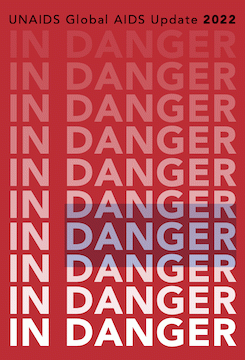Latest UNAIDS data paint a grim picture of the HIV epidemic
SHOBHA SHUKLA - CNS

In Danger, a report by United Nations joint program on HIV/AIDS launched in Montreal, Canada
(Image by CNS) Details DMCA
A new report, "In Danger", launched by UNAIDS just ahead of the 24th International AIDS Conference (AIDS 2022) in Montreal, Canada, paints a grim picture of the global HIV epidemic. It reveals that during the last two years, progress in prevention and treatment of HIV has slowed down and resources have shrunk, putting millions of lives at risk.
As per the report, there were 650,000 AIDS related deaths in 2021, despite there being effective HIV treatment and tools to prevent, diagnose and treat opportunistic infections.
Also 1.5 million new infections occurred in 2021- over 1 million more than the 2025 global targets. This amounts to the smallest annual decline in new HIV infections since 2016 - a drop of only 3.6% between 2020 and 2021.
While 75% (28.7 million) of all people living with HIV have access to antiretroviral treatment, approximately 10 million still do not, and only 52% of the children living with HIV have access to lifesaving medicine. The HIV response is failing to meet the needs of children. Children comprised 4% of people living with HIV in 2021 but 15% of AIDS related deaths, and the gap in HIV treatment coverage between children and adults is increasing rather than narrowing.
Another cause of worry is that new infections have affected young women and adolescent girls disproportionately, with a new infection occurring every two minutes in them in 2021. In 2021, an estimated 250,000 adolescent girls and young women were newly infected with HIV"five times more than the 2025 target. Moreover, in sub-Saharan Africa, girls and young women were three times more likely to acquire HIV in comparison to adolescent boys and young men.
Key populations (people who inject drugs, gay men and other men who have sex with men, sex workers, transgender women) account for less than 5% of the global population, but they and their sexual partners comprised 70% of new HIV infections in 2021. Thus key populations are particularly vulnerable to HIV infection and yet one in four of them are not aware of their HIV status.
(Note: You can view every article as one long page if you sign up as an Advocate Member, or higher).





